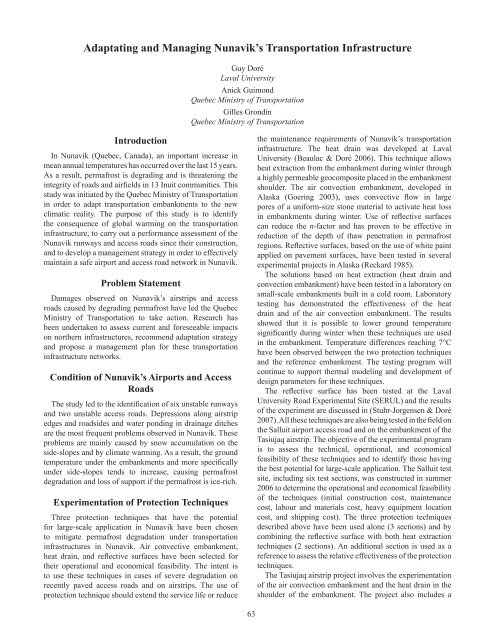Ninth International Conference on Permafrost ... - IARC Research
Ninth International Conference on Permafrost ... - IARC Research
Ninth International Conference on Permafrost ... - IARC Research
You also want an ePaper? Increase the reach of your titles
YUMPU automatically turns print PDFs into web optimized ePapers that Google loves.
Adaptating and Managing Nunavik’s Transportati<strong>on</strong> InfrastructureGuy DoréLaval UniversityAnick Guim<strong>on</strong>dQuebec Ministry of Transportati<strong>on</strong>Gilles Gr<strong>on</strong>dinQuebec Ministry of Transportati<strong>on</strong>Introducti<strong>on</strong>In Nunavik (Quebec, Canada), an important increase inmean annual temperatures has occurred over the last 15 years.As a result, permafrost is degrading and is threatening theintegrity of roads and airfields in 13 Inuit communities. Thisstudy was initiated by the Quebec Ministry of Transportati<strong>on</strong>in order to adapt transportati<strong>on</strong> embankments to the newclimatic reality. The purpose of this study is to identifythe c<strong>on</strong>sequence of global warming <strong>on</strong> the transportati<strong>on</strong>infrastructure, to carry out a performance assessment of theNunavik runways and access roads since their c<strong>on</strong>structi<strong>on</strong>,and to develop a management strategy in order to effectivelymaintain a safe airport and access road network in Nunavik.Problem StatementDamages observed <strong>on</strong> Nunavik’s airstrips and accessroads caused by degrading permafrost have led the QuebecMinistry of Transportati<strong>on</strong> to take acti<strong>on</strong>. <strong>Research</strong> hasbeen undertaken to assess current and foreseeable impacts<strong>on</strong> northern infrastructures, recommend adaptati<strong>on</strong> strategyand propose a management plan for these transportati<strong>on</strong>infrastructure networks.C<strong>on</strong>diti<strong>on</strong> of Nunavik’s Airports and AccessRoadsThe study led to the identificati<strong>on</strong> of six unstable runwaysand two unstable access roads. Depressi<strong>on</strong>s al<strong>on</strong>g airstripedges and roadsides and water p<strong>on</strong>ding in drainage ditchesare the most frequent problems observed in Nunavik. Theseproblems are mainly caused by snow accumulati<strong>on</strong> <strong>on</strong> theside-slopes and by climate warming. As a result, the groundtemperature under the embankments and more specificallyunder side-slopes tends to increase, causing permafrostdegradati<strong>on</strong> and loss of support if the permafrost is ice-rich.Experimentati<strong>on</strong> of Protecti<strong>on</strong> TechniquesThree protecti<strong>on</strong> techniques that have the potentialfor large-scale applicati<strong>on</strong> in Nunavik have been chosento mitigate permafrost degradati<strong>on</strong> under transportati<strong>on</strong>infrastructures in Nunavik. Air c<strong>on</strong>vective embankment,heat drain, and reflective surfaces have been selected fortheir operati<strong>on</strong>al and ec<strong>on</strong>omical feasibility. The intent isto use these techniques in cases of severe degradati<strong>on</strong> <strong>on</strong>recently paved access roads and <strong>on</strong> airstrips. The use ofprotecti<strong>on</strong> technique should extend the service life or reducethe maintenance requirements of Nunavik’s transportati<strong>on</strong>infrastructure. The heat drain was developed at LavalUniversity (Beaulac & Doré 2006). This technique allowsheat extracti<strong>on</strong> from the embankment during winter througha highly permeable geocomposite placed in the embankmentshoulder. The air c<strong>on</strong>vecti<strong>on</strong> embankment, developed inAlaska (Goering 2003), uses c<strong>on</strong>vective flow in largepores of a uniform-size st<strong>on</strong>e material to activate heat lossin embankments during winter. Use of reflective surfacescan reduce the n-factor and has proven to be effective inreducti<strong>on</strong> of the depth of thaw penetrati<strong>on</strong> in permafrostregi<strong>on</strong>s. Reflective surfaces, based <strong>on</strong> the use of white paintapplied <strong>on</strong> pavement surfaces, have been tested in severalexperimental projects in Alaska (Reckard 1985).The soluti<strong>on</strong>s based <strong>on</strong> heat extracti<strong>on</strong> (heat drain andc<strong>on</strong>vecti<strong>on</strong> embankment) have been tested in a laboratory <strong>on</strong>small-scale embankments built in a cold room. Laboratorytesting has dem<strong>on</strong>strated the effectiveness of the heatdrain and of the air c<strong>on</strong>vecti<strong>on</strong> embankment. The resultsshowed that it is possible to lower ground temperaturesignificantly during winter when these techniques are usedin the embankment. Temperature differences reaching 7°Chave been observed between the two protecti<strong>on</strong> techniquesand the reference embankment. The testing program willc<strong>on</strong>tinue to support thermal modeling and development ofdesign parameters for these techniques.The reflective surface has been tested at the LavalUniversity Road Experimental Site (SERUL) and the resultsof the experiment are discussed in (Stuhr-Jorgensen & Doré2007). All these techniques are also being tested in the field <strong>on</strong>the Salluit airport access road and <strong>on</strong> the embankment of theTasiujaq airstrip. The objective of the experimental programis to assess the technical, operati<strong>on</strong>al, and ec<strong>on</strong>omicalfeasibility of these techniques and to identify those havingthe best potential for large-scale applicati<strong>on</strong>. The Salluit testsite, including six test secti<strong>on</strong>s, was c<strong>on</strong>structed in summer2006 to determine the operati<strong>on</strong>al and ec<strong>on</strong>omical feasibilityof the techniques (initial c<strong>on</strong>structi<strong>on</strong> cost, maintenancecost, labour and materials cost, heavy equipment locati<strong>on</strong>cost, and shipping cost). The three protecti<strong>on</strong> techniquesdescribed above have been used al<strong>on</strong>e (3 secti<strong>on</strong>s) and bycombining the reflective surface with both heat extracti<strong>on</strong>techniques (2 secti<strong>on</strong>s). An additi<strong>on</strong>al secti<strong>on</strong> is used as areference to assess the relative effectiveness of the protecti<strong>on</strong>techniques.The Tasiujaq airstrip project involves the experimentati<strong>on</strong>of the air c<strong>on</strong>vecti<strong>on</strong> embankment and the heat drain in theshoulder of the embankment. The project also includes a63
















